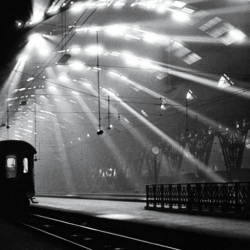DAVID STERRITT, FILM COMMENT
A surprising amount of debate surfaced over the ending of Taste of Cherry,wherein the film’s fascinatingly discursive story—centering on a man’s long discussions with three strangers about his wish to end his life—is followed by a video epilogue showing the actors and filmmakers preparing their final take in the pleasant hillside location where the suicide scene is set. Supporters saw this as a bold extension of Kiarostami’s self-referential complexity, detractors labeled it a confusing cop-out that dodges narrative issues instead of resolving them. The latter group was back in action when The Wind Will Carry Us screened at the Toronto Film Festival last fall, complaining that its reliance on familiar moves—driving scenes, front-seat talkathons, God’s-eye views of Iranian countryside—prove the director is literally spinning his wheels.
Such arguments notwithstanding, it’s plain to anyone who has seriously engaged with Iranian film in general or Kiarostami’s work in particular that Taste of Cherry and The Wind Will Carry Us are full-fledged masterpieces, and that the master who created them deserves any throne he might choose to occupy. Far from repeating a series of trademarked gestures, The Wind Will Carry Us finds Kiarostami weaving one of his most suggestive philosophical webs around the deceptively simple tale of a filmmaker who barges into a rural town, hoping to record a folk ritual that will take place after an old woman’s impending death. One of the movie’s feet is planted firmly in the earthbound world of the village and its inhabitants, while the other roams as freely as the protagonist’s ever-present cell phone—which isn’t so freely, it turns out, since the phone refuses to function unless he climbs into his Land Rover and races to the top of a distant hill. There he chats with a ditch-digger whose face is never seen and finds a human bone that becomes his talisman, signaling that while the wind may carry us, the earth remains our home and our destination.
“Most people want simplicity, they want to get excited, cry, laugh… and we can’t expect the same level of enthusiasm for [poetic] cinema. I’m not comparing my works with theirs, but if you had the paintings of Kandinsky or Braque or Picasso on auction in a park, how many people would buy them, even at $100 apiece? One must have a realistic expectation for art that is real art, as opposed to what is entertainment. The general public won’t pay for a picture if they can’t quite understand what’s in it and what it says.”
“The poetic film is like a puzzle where you put the pieces together and they don’t necessarily match. You can make whatever arrangement you yourself would like. Contrary to what the general public is used to, it doesn’t give you a clear result at the end. And it doesn’t give you advice!””On-the-spot creation of dialogue has been necessary because it’s the only way I could work with people who are not professional actors, and some of the moments you see in my movies have surprised me as well as others. I don’t give dialogue to the actors, but once you explain the scene to them, they just start talking, beyond what I would have imagined. It’s like a cycle, and I don’t know where it starts and ends: I don’t know whether I’m teaching them what to say, or they’re teaching me what to receive!”
|
|
ABC Africa |


